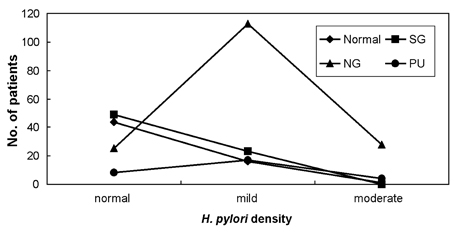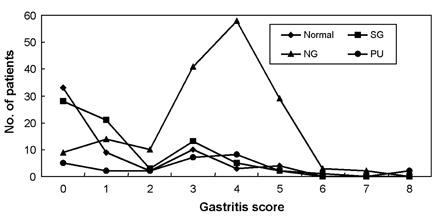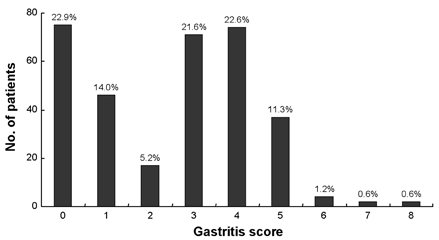Yonsei Med J.
2007 Apr;48(2):240-246. 10.3349/ymj.2007.48.2.240.
Nodular Gastritis and Pathologic Findings in Children and Young Adults with Helicobacter pylori Infection
- Affiliations
-
- 1Department of Pediatrics, Yonsei University College of Medicine, Seoul, Korea. kschung58@yumc.yonsei.ac.kr
- 2Department of Pathology, Yonsei University College of Medicine, Seoul, Korea.
- KMID: 1779526
- DOI: http://doi.org/10.3349/ymj.2007.48.2.240
Abstract
- PURPOSE
The aim of this study was to investigate the pathologic characteristics of nodular gastritis in children and young adults infected with Helicobacter pylori (H. pylori). MATERIALS AND METHODS: A total of 328 patients were enrolled in this study, and the diagnosis of H. pylori infection was done with gastroduodenal endoscopy concomitant with a CLO
MeSH Terms
Figure
Reference
-
1. Sherman P, Czinn S, Drumm B, Gottrand F, Kawakami E, Madrazo A, et al. Helicobacter pylori infection in children and adolescents: Working Group Report of the First World Congress of Pediatric Gastroenterology, Hepatology, and Nutrition. J Pediatr Gastroenterol Nutr. 2002. 35:Suppl 2. S128–S133.2. Macarthur C, Saunders N, Feldman W. Helicobacter pylori, gastroduodenal disease, and recurrent abdominal pain in children. JAMA. 1995. 273:729–734.3. Queiroz DM, Rocha GA, Mendes EN, Carvalho AS, Barbosa AJ, Oliveira CA, et al. Differences in distribution and severity of Helicobacter pylori gastritis in children and adults with duodenal ulcer disease. J Pediatr Gastroenterol Nutr. 1991. 12:178–181.4. Hassall E, Dimmick JE. Unique features of Helicobacter pylori disease in children. Dig Dis Sci. 1991. 36:417–423.5. Dixon MF, Genta RM, Yardley JH, Correa P. Classification and grading of gastritis. The updated Sydney System. International Workshop on the Histopathology of Gastritis, Houston 1994. Am J Surg Pathol. 1996. 20:1161–1181.6. De Giacomo C, Fiocca R, Villani L, Lisato L, Licardi G, Diegoli N, et al. Helicobacter pylori infection and chronic gastritis: clinical, serological, and histologic correlations in children treated with amoxicillin and colloidal bismuth subcitrate. J Pediatr Gastroenterol Nutr. 1990. 11:310–316.7. Bujanover Y, Konikoff F, Baratz M. Nodular gastritis and Helicobacter pylori. J Pediatr Gastroenterol Nutr. 1990. 11:41–44.8. Bujanover Y, Rief S, Yahav J. Helicobacter pylori and peptic disease in the pediatric patient. Pediatr Clin North Am. 1996. 43:213–234.9. Sbeih F, Abdullah A, Sullivan S, Merenkov Z. Antral nodularity, gastric lymphoid hyperplasia and Helicobacter pylori in adults. J Clin Gastroenterol. 1996. 22:227–230.10. Robert ME, Weinstein WM. Helicobacter pylori associated gastric pathology. Gastroenterol Clin North Am. 1993. 22:59–72.11. Zaitoun AM. Histological study of chronic gastritis from the United Arab Emirates using the Sydney system of classification. J Clin Pathol. 1994. 47:810–815.12. Belair PA, Metz DC, Faigel DO, Furth EE. Receiver operator characteristic analysis of endoscopy as a test for gastritis. Dig Dis Sci. 1997. 42:2227–2233.13. Genta RM, Hammer HW. The significance of lymphoid follicles in the interpretation of gastric biopsy specimens. Arch Pathol Lab Med. 1994. 118:740–743.14. Blaser MJ. Helicobacter pylori and the pathogenesis of gastroduodenal inflammation. J Infect Dis. 1990. 161:626–633.15. Bahu Mda G, da Silveira TR, Maguilnick I, Ulbrich-Kulczynski J. Endoscopic nodular gastritis: an endoscopic indicator of high-grade bacterial colonization and severe gastritis in children with Helicobacter pylori. J Pediatr Gastroenterol Nutr. 2003. 36:217–222.16. Marshall BJ, Warren JR. Unidentified curved bacilli in the stomach of patients with gastritis and peptic ulceration. Lancet. 1984. 1:1311–1315.17. Moss S, Calam J. Helicobacter pylori and peptic ulcer: the present position. Gut. 1992. 33:289–292.18. Misiewicz JJ. The Sydney System: a new classification of gastritis. Introduction. J Gastroenterol Hepatol. 1991. 6:207–208.19. Schindler R. Gastritis. 1947. New York: Grune & Stratton.20. Price AB. The Sydney system: histological division. J Gastroenterol Hepatol. 1991. 6:209–222.21. Choi WJ, Kim JW, Chung KS. Therapeutic outcome and recurrence rate of Helicobacter pylori infection in children. Korean J Pediatr Gastroenterol Nutr. 1998. 1:37–44.22. Choi IK, Lee SY, Chung KS. Effect of one or two week triple therapy with omeprazole, amoxicillin, and clarithromycin on eradication of Helicobacter pylori infection in children. Korean J Pediatr Gastroenterol Nutr. 2002. 1:19–25.23. Rafeey M, Jafari Rouhi AH, Gassemi BA, Rouhi AJ. Relationship between endoscopic nodular gastritis and Helicobacter pylori infection in children. Indian J Gastroenterol. 2004. 23:138–139.24. Kamada T, Sugiu K, Hata J, Kusunoki H, Hamada H, Kido S, et al. Evaluation of endoscopic and histological findings in Helicobacter pylori-positive Japanese young adults. J Gastroenterol Hepatol. 2006. 21:258–261.25. Kato S, Nakajima S, Nishino Y, Ozawa K, Minoura T, Konno M, et al. Association between gastric atrophy and Helicobacter pylori infection in Japanese children: a retrospective multicenter study. Dig Dis Sci. 2006. 51:99–104.
- Full Text Links
- Actions
-
Cited
- CITED
-
- Close
- Share
- Similar articles
-
- Endoscopic and Pathologic Analysis of Pediatric Helicobacter pylori Gastritis
- Analysis of Gene Expression in Helicobacter pylori-associated Nodular Gastritis in Children Using Microarray
- The value of Helicobacter pylori IgG antibody in estimating the severity of gastritis in children
- Updates on the Diagnosis of Helicobacter pylori Infection in Children: What Are the Differences between Adults and Children?
- Prediction of Helicobacter pylori Infection by Endoscopic Severity of Erythematous Gastritis in Asymptomatic Adults




